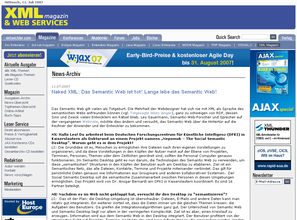Interview with me on xml-magazin.de
I met a journalist from xml-magazin.de at the webinale 2007, and he interviewed me recently. Interview is in German!

https://xml-magazin.de/itr/news/psecom,id,36225,nodeid,68.html
I answer questions about Semantic Desktop, Semantic Web, and RDF, and often the question is "why is RDF not used?", well, ...

https://xml-magazin.de/itr/news/psecom,id,36225,nodeid,68.html
I answer questions about Semantic Desktop, Semantic Web, and RDF, and often the question is "why is RDF not used?", well, ...
|
leobard - 11. Jul, 17:16
|
|
pavel1998 (guest) - 12. Jul, 14:09
RSS and the Semantic Web
According to Wikipedia (https://en.wikipedia.org/wiki/Rss), "RSS 0.90 was the original Netscape RSS version. This RSS was called RDF Site Summary, but was based on an early working draft of the RDF standard, and was not compatible with the final RDF Recommendation." (this was in 1999)
RSS0.9x didn't use RDF any more, it turned up once more in RSS1.0 and disappeared again with RSS2.0
So I strongly doubt that it is a good example for the success of any Semantic Web effort, isn't it?
RSS0.9x didn't use RDF any more, it turned up once more in RSS1.0 and disappeared again with RSS2.0
So I strongly doubt that it is a good example for the success of any Semantic Web effort, isn't it?
leobard - 19. Jul, 00:25
depends
I am well aware that not all versions of RSS are RDF. Still, I am confident to say its a success, because the semantic web idea is to make a web of data, annotating URIs with links to other URIs. So although the serialization format has changed, RSS is a perfect example for the idea behind.
that winer's 0.91 was faster adopted compared to the 1.0 version is a fact. I think we would have better software, if we had the 1.0 version now, because then I wouldn't need to make all those mashups by hand... :-)
that winer's 0.91 was faster adopted compared to the 1.0 version is a fact. I think we would have better software, if we had the 1.0 version now, because then I wouldn't need to make all those mashups by hand... :-)
- add comment - 0 trackbacks







XML-RDF : Baum-Graph
ich bin erstaunt über die Aussage: "XML, das aus Bäumen besteht, auf Graphen zu beschränken. Im Prinzip heißt das: ich lasse Teile des XML-Baumes weg, um eine einfachere Struktur zu haben. Diese kann ich dann sehr effizient in eine Datenbank speichern und dann viel besser abfragen als man das von XPath oder XQuery gewohnt ist."
Kannst Du mir das etwas genauer erläutern?
Für mich gilt: XML ist ein Baum mit einer Wurzel, RDF ist ein Graph. Ein Graph ist eine komplexere Struktur als ein Baum, man lässt keine Teile weg, beschränkt also nicht, sondern fügt hinzu. Ein Graph erhöht außerdem die Komplexität für die Anfragebearbeitung (fehlende Ordnung, etc)
Viele Grüße,
Bastian
RDF/XML ist eine beschränkung von XML
s - p -o (siehe rdf primer).
während im XML graph baumstrukturen sind, man kann etwa das hier machen (ohne klammern, geht nicht hier)
root / knoten / knoten / wert.
root / knoten / wert.
root / knoten / knoten / knoten.
rdf/xml ist:
root / knoten / predicate / knoten / predicate / knoten
vereinfacht gesagt, jede zweite stufe im XML baum ist ein knoten, dazwischen immer die predicate.
XML kann auch Text mit elementen mischen, und vieles andere, das in RDF fehlt.